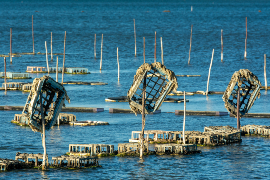Spotlights
Fish Farmer, Aquaculture Technician, Hatchery Manager, Aquatic Food Producer, Mariculture Specialist, Shellfish Grower
From the salmon in your sushi to the shrimp on your dinner plate, an increasing share of the world’s seafood is farmed—not wild-caught. As an Aquaculturist, you’ll be at the heart of the action, raising fish, shellfish, and aquatic plants in vibrant underwater “gardens” that help feed communities and protect our planet. This career is about so much more than just fish tanks—think high-tech ocean farms, genetic breakthroughs for healthier seafood, and even restoring wild habitats teeming with life!
Aquaculturists might run massive ocean fish pens, high-tech indoor tanks, or quiet coastal shellfish farms. They monitor water quality, regulate feeding schedules, breed healthy stock, and protect aquatic life from disease and stress. It’s a hands-on career that combines biology, technology, and environmental science—ideal for someone who loves working with nature, water, and science all at once.
- Helping feed the world sustainably with high-protein, low-footprint food
- Working outdoors and staying close to the water
- Watching tiny hatchlings grow into harvest-ready fish or shellfish
- Contributing to ocean conservation by farming instead of overfishing
- Using technology and science to solve real-world problems
Working Schedule
Aquaculturists typically work full-time, with schedules that can include early mornings, weekends, or holidays—especially during spawning season or in hatchery operations. In some cases, they live on or near the site to provide around-the-clock monitoring of aquatic systems.
Typical Duties
- Monitor water quality—oxygen levels, temperature, pH, and salinity
- Feed fish or shellfish and manage automatic feeding systems
- Breed aquatic animals and care for hatchlings
- Check for diseases or parasites and administer treatments
- Clean tanks, ponds, or pens and maintain equipment
- Record growth rates and adjust feed or stocking density
- Harvest and sort mature animals for processing or sale
Additional Responsibilities
- Install or repair filtration and aeration systems
- Work with veterinarians or biologists to study fish health
- Manage breeding programs for genetic improvement
- Coordinate with buyers, processors, or transport companies
- Ensure operations follow food safety and environmental laws
- Research new species or farming methods to improve yields
- Train and supervise staff, interns, or seasonal workers
- Contribute to conservation efforts, such as restocking wild populations
The day usually begins early by checking the water conditions before the sun rises. A pump might need adjusting, or a batch of shrimp could be molting and extra sensitive. After feeding time, it's on to cleaning tanks, sampling fish for health checks, or running tests on water quality.
Afternoons might involve prepping for a harvest, coordinating delivery with a buyer, or troubleshooting a filtration issue. Aquaculturists often balance time between hands-on work and data tracking.
During spawning or harvesting season, hours can stretch long. But many in the field say the work is deeply satisfying. As real-life aquaculturist and researcher Dan Ward once put it: “Working on the water producing seafood for a living, but being home every night.”
Soft Skills
- Observation and attention to detail
- Problem-solving
- Patience
- Physical stamina
- Communication
- Teamwork
- Time management
- Curiosity and continuous learning
- Adaptability to weather and conditions
- Responsibility (animals depend on you!)
Technical Skills
- Aquaculture system operations (tanks, ponds, cages)
- Water chemistry testing and adjustment
- Fish biology and life cycle knowledge
- Feeding and nutrition planning
- Disease prevention and treatment
- Recordkeeping and data analysis
- Equipment maintenance and repair
- Computer systems for environmental monitoring
- Knowledge of food safety standards
- Understanding of sustainability practices
- Hatchery Technician – Raises young fish or shellfish from eggs
- Grow-Out Operator – Manages fish until they reach market size
- Mariculture Specialist – Works in ocean-based farms
- Recirculating System Manager – Oversees high-tech indoor tanks
- Shellfish Farmer – Focuses on oysters, mussels, clams
- Aquaponics Grower – Combines fish farming with vegetable growing
- Aquatic Biologist (with training) – Researches or supports farm systems
- Fish and shellfish farms
- Hatcheries (government, tribal, or private)
- Aquaponics or hydroponics facilities
- Seafood processing companies
- State and federal fisheries agencies
- Marine conservation groups
- Research labs and universities
- International development projects
This isn’t a clean lab job! Aquaculturists often work in wet, muddy, or coastal environments, sometimes in bad weather. Fish don’t take holidays—so you may be called in early, late, or on weekends to deal with emergencies like oxygen crashes or storms.
It also takes patience and vigilance. Fish can’t speak up if something’s wrong, so it’s your job to notice signs early and act fast. But if you love the outdoors and want to work with your hands and your brain, this career can be incredibly fulfilling.
Still, for those who thrive outdoors, enjoy problem-solving, and want a career rooted in both science and stewardship, aquaculture offers real satisfaction and the chance to feed a growing world sustainably.
The aquaculture industry is rapidly evolving to meet growing global demand for sustainable seafood, with farm-raised fish helping to ease pressure on overfished wild stocks. Innovations like indoor recirculating aquaculture systems (RAS) are making it possible to raise fish in urban or landlocked areas, while aquaponics—integrating fish and plant production—is gaining traction in small-scale farming.
Technological advancements such as remote sensors, automation, and AI are transforming how farms monitor water quality and animal health. As climate change impacts aquatic environments, farms are adapting to higher temperatures and extreme weather conditions.
Meanwhile, the shift to alternative feeds, including insect meal and algae, is reducing reliance on traditional wild-caught fishmeal, making aquaculture more sustainable than ever!
Many aquaculturists grew up drawn to water and wildlife—spending time fishing, snorkeling, or building backyard ponds. They often had a knack for caring for animals, whether it was a pet fish or a classroom terrarium. In school, they were the ones fascinated by biology labs, marine documentaries, and aquarium visits. Some joined science fairs with ocean-themed projects, helped with beach cleanups, or got involved in environmental clubs that sparked their interest in aquatic life and sustainability.
Aquaculturists typically begin with a certificate, associate's, or bachelor’s degree, depending on their career goals. Technician or hatchery roles may only require a two-year program, while leadership, research, or regulatory positions usually call for a four-year degree.
Common college courses include:
- Hatchery Management
- Water Quality Monitoring
- Aquatic Animal Nutrition
- Disease Prevention and Biosecurity
- Recirculating Aquaculture Systems (RAS)
- Marine Ecology
- Aquaponics System Design
Optional Certifications:
- Aquaculture Technician Certificate (requirements vary by region)
- HACCP for Aquatic Products (food safety compliance)
- SCUBA Certification (for underwater tasks and inspections)
- Aquatic Animal Health Short Courses
- Aquaponics Operations Certification
- Volunteer at hatcheries, aquariums, coastal cleanups, or environmental nonprofits
- Build and maintain your own small aquaponics, hydroponics, or aquarium system
- Enter science fairs or competitions with marine biology or aquaculture projects
- Apply for internships or summer jobs at fish farms, aquaponics facilities, or fisheries research centers
- Join school science or environmental clubs, or start a marine science interest group
- Attend agri-fishery expos, industry conferences, or aquaculture workshops in your region
- Learn to test water pH, ammonia, nitrates, and dissolved oxygen using simple kits
- Take free online courses on marine ecosystems, aquatic health, or sustainable food systems
- Shadow professionals working in hatcheries, aquaculture labs, or seafood companies
- Read books, articles, and documentaries about ocean farming, climate change, and sustainable seafood production
- Participate in coastal or river ecosystem monitoring projects through science outreach groups or local universities
Look for programs that offer:
- Hands-on training in aquaculture labs or outdoor systems
- Internships or partnerships with working farms or hatcheries
- Courses in fish health, water quality, and production systems
- Strong ties to marine research centers or coastal communities
Programs to consider:
- University of Maine – Aquaculture and Marine Sciences
- University of the Philippines Visayas – Fisheries and Aquatic Sciences
- Southern Illinois University – Fisheries and Aquaculture
- Auburn University – School of Fisheries, Aquaculture, and Aquatic Sciences
- Maritime or polytechnic colleges with strong fisheries programs
- Build a strong resume that highlights relevant coursework, water quality testing skills, and any hands-on experience—whether from labs, backyard aquaponics, or internships.
- Create a LinkedIn profile and upload photos or short descriptions of aquaculture projects you've done. Use keywords like recirculating systems, fish health, aquaponics, and sustainable seafood.
- Search on job boards such as AgCareers.com, AquacultureJobs.com, Indeed, Hatchery International, and company websites for roles like Hatchery Assistant, Aquaculture Technician, Aquaponics Operator, or Fish Farm Worker.
- Reach out to local fish farms, hatcheries, universities, and aquaponics startups—even if they’re not advertising jobs.
Express your interest and ask if you can visit or volunteer. - Attend aquaculture expos, marine science conferences, or fisheries association meetups to connect with professionals in the field. These events often include job boards or recruiter booths.
- Practice interview questions like:
▸ “How would you handle a sudden drop in dissolved oxygen levels in a tank?”
▸ “What strategies would you use to prevent disease in a hatchery system?”
▸ “How do you balance pH and nutrient levels in an aquaponics setup?”
- Ask professors, hatchery supervisors, or marine biologists you’ve worked with if they’re willing to write recommendation letters or be listed as references.
- Dress neatly (and appropriately for farm or lab tours!) and show your enthusiasm for fish, science, and sustainability.
- Specialize in fish health, recirculating systems, or breeding programs
- Get certified in aquatic biosecurity, system design, or nutrition
- Move into management as a Hatchery Manager, Production Supervisor, or Technical Sales Rep
- Conduct research or policy work through universities or government agencies
- Start your own small-scale aquaponics or fish farm
- Network through industry groups like the World Aquaculture Society
- Stay current with trends in seafood markets, water technology, and sustainability
- Stay active in professional organizations such as the World
Aquaculture Society, Asian Fisheries Society, or local marine science networks. - Attend conferences, present research, and build connections.
- Keep up with innovations in sustainable seafood, alternative feeds, breeding technology, and climate-resilient aquaculture systems.
Websites:
- World Aquaculture Society
- SEAFDEC
- FAO Aquaculture Portal
- FishFarmingExpert.com
- The Fish Site
- AgCareers.com – Aquaculture Jobs
- Aquaponics Association
- USDA National Institute of Food and Agriculture – Aquaculture
- AquaBounty Technologies
- LinkedIn Aquaculture Jobs
- Indeed Aquaculture Jobs
Books
- Aquaculture: Farming Aquatic Animals and Plants by John S. Lucas & Paul C. Southgate
- Small-Scale Aquaculture by Hillary Egna & Carl Boyd
- The Urban Farmer's Guide to Aquaponics by Paul Gauthier
If you’re not quite sure Aquaculturist is the perfect path for you, don’t worry—there are plenty of other rewarding careers where you can still apply your love for science, nature, and the environment. Consider exploring related fields such as:
- Marine Biologist
- Aquaponics Technician
- Fisheries Technician
- Environmental Science Technician
- Agricultural Water Manager
- Aquatic Veterinarian Assistant
- Seafood Quality Control Inspector
- Sustainable Agriculture Educator
Newsfeed

Featured Jobs

Online Courses and Tools





